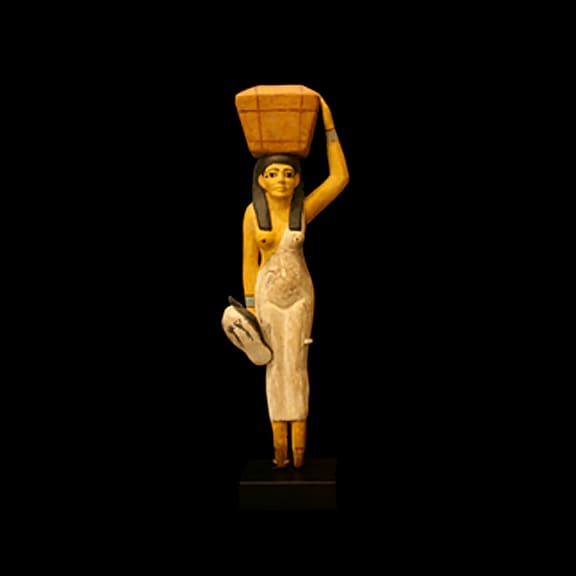Wooden Female Gift Bearer, 1940 BCE - 1750 BCE
Wood
height 24.8 cm
height 9 3/4 in
height 9 3/4 in
SP.642 (LSO)
Further images
This offering bearer was designed to accompany her 12th dynasty “master” into the afterlife. This period of Egyptian history is characterised by notable feats of architecture and engineering such as...
This offering bearer was designed to accompany her 12th dynasty “master” into the afterlife. This period of Egyptian history is characterised by notable feats of architecture and engineering such as the creation of a canal through the Wadi Tumilat, and various temples of considerable note. It also witnessed important artistic achievements including the creation of numerous papyri that have gone on to define most of what we know about the Middle Kingdom. The kingdom moved from Thebes to somewhere near the Faiyum Oasis at this time, and was renamed Amenemhat-itj-tawy. Diplomatic relations were established with Byblos and various Aegean communities, while military missions were sent to Nubia, the Levant and up the Nile to the Third Cataract and beyond.
The cultural palimpsest of the 12th dynasty was the most strident of the Middle Kingdom dynasties, which – in turn – was heavily reliant upon Old Kingdom traditions. Burial practices during this period were traditionally flamboyant, with food, drink, furniture, jewellery and a full cast of slaves, assistants and other members of staff accompanying the deceased into the afterlife. The current piece represents a bearer; female bearers did work in the homes of rich Egyptians as maids and culinary assistant, perhaps with other duties in certain cases as suggested by her pose and raiment.
She is here represented as a polychrome wooden figure, carrying nutriments for her lord and master. She is wearing a simple white linen dress to the mid-calf, draped off her left shoulder and leaving her right breast exposed. She also wears a pair of grey-silver armlets, one on each wrist, and her hair carefully coiffed around her ears and draped down to her breasts. She carries a live duck by the wings in her right hand, and her left supports a wickerwork basket – presumably containing food – borne upon her head. Her face is serene and placid, with detailing in black paint around the eyes, with the traditional kohl elongation towards the sides.
Like most societies, Egypt operated on the basis of conspicuous consumption – this is amply evident from the fact that they created some of the ancient world’s most flamboyant architecture. Unusually, however, they continued this principle into the hereafter. It is hard to overestimate Egypt’s preoccupation with death; the Book of the Dead was, after all, their main religious treatise, while much of their iconography and social stratification was based upon what happened after one died. As a result, the most wealthy and influential people manifested their uniqueness and proximity to the pharaohs (themselves gods, in the eyes of their people) by making as much of an impact as possible with grave furniture and funeral preparations. A piece such as this would have been enormously expensive and exclusive, and would only have accompanied a very high status burial. This is a truly spectacular and beautiful piece of ancient art.
The cultural palimpsest of the 12th dynasty was the most strident of the Middle Kingdom dynasties, which – in turn – was heavily reliant upon Old Kingdom traditions. Burial practices during this period were traditionally flamboyant, with food, drink, furniture, jewellery and a full cast of slaves, assistants and other members of staff accompanying the deceased into the afterlife. The current piece represents a bearer; female bearers did work in the homes of rich Egyptians as maids and culinary assistant, perhaps with other duties in certain cases as suggested by her pose and raiment.
She is here represented as a polychrome wooden figure, carrying nutriments for her lord and master. She is wearing a simple white linen dress to the mid-calf, draped off her left shoulder and leaving her right breast exposed. She also wears a pair of grey-silver armlets, one on each wrist, and her hair carefully coiffed around her ears and draped down to her breasts. She carries a live duck by the wings in her right hand, and her left supports a wickerwork basket – presumably containing food – borne upon her head. Her face is serene and placid, with detailing in black paint around the eyes, with the traditional kohl elongation towards the sides.
Like most societies, Egypt operated on the basis of conspicuous consumption – this is amply evident from the fact that they created some of the ancient world’s most flamboyant architecture. Unusually, however, they continued this principle into the hereafter. It is hard to overestimate Egypt’s preoccupation with death; the Book of the Dead was, after all, their main religious treatise, while much of their iconography and social stratification was based upon what happened after one died. As a result, the most wealthy and influential people manifested their uniqueness and proximity to the pharaohs (themselves gods, in the eyes of their people) by making as much of an impact as possible with grave furniture and funeral preparations. A piece such as this would have been enormously expensive and exclusive, and would only have accompanied a very high status burial. This is a truly spectacular and beautiful piece of ancient art.





